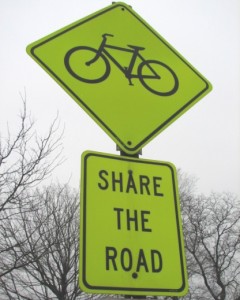What's New
Better Weather + Longer Days = More Bike Crashes
 AMATS wants to remind cyclists and motorists in the Greater Akron area that temperatures and daylight hours aren’t the only things increasing as summer approaches. Their chances of being in a bicycle-related accident are going up too.
AMATS wants to remind cyclists and motorists in the Greater Akron area that temperatures and daylight hours aren’t the only things increasing as summer approaches. Their chances of being in a bicycle-related accident are going up too.
As the region’s metropolitan planning organization, AMATS compiles crash-related data for various safety studies and improvement projects. The agency’s most recent three-year crash report spans 2015 through 2017 and is based on its analysis of nearly 59,000 motor vehicle, bicycle and pedestrian-related crash records for the area’s roadway sections and intersections provided by the Ohio Department of Transportation (ODOT).
The report finds that the number of bicycle-related crashes within the Greater Akron area begins a steady climb in February before spiking in July. February is one of the lowest months in terms of crashes with seven recorded in the region during the period. With its sunshine and vacation days, July is the worst month for crashes with a peak of 38 before dropping off to 27 crashes in August. (Agency officials note that crashes tend to have a secondary spike of 36 in September, possibly due to less daylight hours and children riding bikes to school.)
Dave Pulay, the agency’s transportation improvement program (TIP) coordinator, says that it’s not surprising that there are more bicycle-related crashes during the summer months when outdoor conditions are more inviting to cyclists and motorists in Portage and Summit counties. A contributing factor to the summertime increase in crash totals may be that school is out and more children are riding their bikes as part of their outdoor playtime.
“Fortunately, there are some common-sense precautions that people can take to lessen their chances of adding to our statistics.”
– AMATS TIP Coordinator Dave Pulay
Out of the 242 total bicycle-related crashes during the period, 191 or 79 percent resulted in an injury and three resulted in fatalities. Pulay sadly notes that many crashes involve younger cyclists, including children. The largest age group involved bicycle-related crashes during the period was 14-year-olds with 18 crashes. “Fortunately, there are some common-sense precautions that people can take to lessen their chances of adding to our statistics,” he adds.
Pulay reminds the region’s drivers that Ohio has had a “three-foot rule” in place since 2017. This rule requires motorists to provide no less than a three-foot buffer between their vehicles and cyclists while passing on a road. Motorists found violating this law face a misdemeanor charge and a $150 fine.
With 64 percent of the area’s bicycle-related crashes occurring at intersections, Pulay cautions cyclists to obey stop signs and traffic signals the same as motorists do. If dedicated turn lanes are marked, a cyclist should use them the same manner as any other vehicle. If a cyclist encounters a roundabout, they may ride through it like other traffic or walk their bikes through the pedestrian crosswalks.
AMATS offers the following additional safety tips for the Greater Akron area’s motorists and cyclists:
- Cyclists can promote safe interactions with motorists by being courteous yet assertive through such actions as riding single file when in groups and using appropriate hand signals and eye contact.
- Drivers should treat cyclists like any other slow-moving vehicle when they are attempting to pass. Motorists should pass cyclists only when there are no oncoming vehicles and sight lines are clear. When passing a cyclist, motorists should remember the three-foot rule.
- Motorists should beware of cyclists who might be in their vehicle’s blind spots or are otherwise difficult to see.
- Cyclists should wear a properly fitted bicycle helmet.
- Cyclists can improve their visibility to others by wearing bright clothing even during the daytime and using lights and reflectors at night or in low-light conditions.
- Cyclists should always ride with traffic and in the same direction as other vehicles.
Pulay says that additional information is available on the agency’s website devoted to cycling in the Greater Akron area – switching-gears.org. The site includes the agency’s free Bike User Map so that cyclists may plan routes according to their comfort level and ability. For more information, please call AMATS at 330-375-2436.